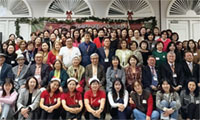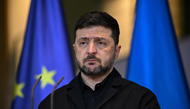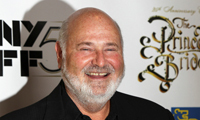A Physician’s Crusade To Revive Physical Exams
STANFORD, California - Dr. Abraham Verghese is on a mission to bring back the physical exam. The touching, looking and listening were the once prized, almost magical skills of the doctor who could swiftly diagnose an ailment using just keen eyes, practiced hands and a stethoscope.
The senior associate chairman for the theory and practice of medicine at Stanford University, Dr. Verghese is also the author of two highly acclaimed memoirs, and a best-selling novel, “Cutting for Stone.” Art and medicine may seem disparate , but Dr. Verghese, 55, insists that for him they are one. He says his two careers have the same prerequisite: “infinite curiosity about other people.”
“People are endlessly mysterious,” he says. Besides his medical degree, he has a writing degree from the University of Iowa. The physical seems to be wasting away, he says, in an era of countless lab tests and too-brief doctor visits.
He jokes that a person could show up with a finger missing, and doctors would insist on an M.R.I., a CT scan and an orthopedic consult to confirm it. Dr. Verghese trained in Ethiopia and India, where fancy equipment was scarce.
He still believes a thorough exam can yield vital information and help doctors figure out which tests to order and which to skip. A proper exam also earns trust, he said, and serves as a ritual that transforms two strangers into doctor and patient. His ideas have resonated with many doctors. With colleagues,
he developed the Stanford 25, a list of techniques that every doctor should know, like how to listen to the heart or look at blood vessels at the back of the eye.
Making hospital rounds , Dr. Verghese is in his element He told students about an unusual condition that produces silver-colored stools. He had interns palpating their own thighs as he showed them exactly where to stick the needle when culturing an abscess. “Wow!” said one.
“This is great.” Dr. Verghese smiled. “I am here to astound you,” he said. At times, he said, he feels almost embarrassed by all the interest in his work, because the techniques are the same ones he learned decades ago. Born in Ethiopia, to Indian teachers, the family’s expectations were high.
“You were a doctor, engineer, lawyer or a failure,” he said. He attended medical school in Addis Ababa, but after civil war broke out in Ethiopia in 1974 he joined his parents, who had moved to the United States .
Living in New Jersey , he found he would have to start over, earning a bachelor’s degree and then applying to medical schools, despite two years of training. He took a night job as a hospital orderly, and says he lost his way .
Then one night at work he realized what he would be throwing away if he did not resume his training. He finished medical school in India, and then did his residency in the United States. He worked in Tennessee during the early days of the AIDS epidemic .
Before AIDS, he said: “I must have been a conceited ass, full of knowledge. AIDS humbled a whole generation.” Once a patient, near death, awoke when Dr. Verghese arrived, and opened his shirt to be examined one last time. “It was like an offering,” Dr. Verghese said, with tears in his eyes. “To preside over the bed of a dying man in his last few hours.
I listen, I thump, I don’t even know what I’m listening for. But doing it says: ‘I will never leave you. I will not let you die in pain or alone.’ There’s not a test you can offer that does that.”
스마터리빙
more [ 건강]
[ 건강]이제 혈관 건강도 챙기자!
[현대해운]우리 눈에 보이지 않기 때문에 혈관 건강을 챙기는 것은 결코 쉽지 않은데요. 여러분은 혈관 건강을 유지하기 위해 어떤 노력을 하시나요?
 [ 건강]
[ 건강]내 몸이 건강해지는 과일궁합
 [ 라이프]
[ 라이프]벌레야 물럿거라! 천연 해충제 만들기
 [ 건강]
[ 건강]혈압 낮추는데 좋은 식품
[현대해운]혈관 건강은 주로 노화가 진행되면서 지켜야 할 문제라고 인식되어 왔습니다. 최근 생활 패턴과 식생활의 변화로 혈관의 노화 진행이 빨라지고
사람·사람들
more많이 본 기사
- 마약딛고 함께 영화도 만들었는데…라이너감독 살해한 아들 체포
- 브라운대 총격사건 수사 난항 겪나…체포한 용의자 석방
- 트럼프, 라이너감독 피살에 “나에 대한 발작적 집착이 분노유발”
- ‘베네수 코앞’ 트리니다드토바고 “미군에 공항접근 허용”
- “연준의장 유력후보 해싯, ‘트럼프와 너무 가깝다’ 반대론 직면”
- “내 한국인 남편, 40일 넘게 개처… 1
- ‘15년째 활동 無’ 원빈 근황, 이시언 유튜브서 공개..”잘 지내는 중”
- 미·우크라 이틀간 종전협상…안전보장 진전, 영토 문제 난항
- 상무, 고려아연의 美제련소 건설 투자… 1
- 박나래 ‘링거·주사 이모’ 난리통 속 결국..MBC ‘팜유트립’ 제작 무산
- 美 지한파 중진 “한국 등과 다변화된 광물 공급망 구축해야”
- 국과수 “김수현·故 김새론 녹취파일, AI 조작 판정 불가”
- 현대車사장, ‘구금사태’ 조지아서 “일자리 4만개 창출할것”
- 180일 수사 마치고 재판 넘긴 내란특검…이제 ‘법원의 시간’
- 美당국자 “러, 우크라 EU가입에 열… 1
- ‘해리가 샐리를 만났을 때’ 롭 라이너 감독 부부 피살
- ‘128개 홈디포 매장서 319건 절도’ 플러싱 기반 전문절도단 일망타진
- NYT “美 SEC, 트럼프 재집권 후 암호화폐 소송 중단”
- 전재수, 통일교 행사 참석 의혹에 “고향서 벌초했다” 반박
- 美 “대외원조 중단한 적 없어…국가안보전략 원칙 맞춰 지속”
- 러 “우크라 나토 비가입, 평화 대화의 초석될 것”
- 野 “30년前 폭행 검증해야”…정원오… 1
- 원지, ‘6평 사무실’ 논란 후 첫 방송 출연..無편집 “적응 안 돼”
- 경찰, 쿠팡 6차 압수수색 11시간30분만에 종료 “데이터 방대”
- 항공기 승객정보 활용 추방 확대
- 역시 호날두! 북중미 WC 인기 티켓 1위는? 포르투갈-콜롬비아전... 3위가 한국-멕시코전 “개최국 효과”
- 워싱턴 한국학교협의회, 제37회 교사의 밤
- 뉴욕 백화점서 아기 기저귀 갈던 엄마, 정신질환자에 흉기피습
- ‘지독한 플래툰’ 김혜성도 71G 뛰었는데, 美 팬그래프 ‘송성문 ML 36G 타율 0.251’ 예상
- 비극 속 시민의 용기 총격범 맨손 제압
- [경제 트렌드] 외식비 줄이는 소비자… ‘팁 공포’ 한몫
- 백화점서 아기 기저귀 갈던 엄마 40대 정신질환자에 흉기 피습
- 테슬라 11월 미국 판매… 4년만에 최저
- 오늘의 베네수엘라가 내일의 동아시아국… 2
- 통계로 본 올해 대한항공… ‘캡틴 아메리카’ 가장 많이 보고, 최다 방문지 도쿄
- 서폭카운티 우정국 직원 우편물 절도 혐의 체포
- 안수화 회장 연임 확정
- 지구촌 또 ‘총기 난사’… 미·호주 잇단 참사
- 피로 얼룩진 주말…지구촌 곳곳 총격사건 잇달아
- 마약딛고 함께 영화도 만들었는데…라이너감독 살해한 아들 체포
- “성과는 있었지만 아직 끝 아냐” 2
- ‘내포 신도시 뉴욕설명회’성황
- ‘박성광♥’ 이솔이, 암 투병 중 안타까운 소식 “병원 몇 번 가는 건지..내 탓”
- ‘마리화나 규제 대폭 완화’ 트럼프, 행정명령 검토
- 워싱턴 지역 올 겨울 두 번째 눈
- 버지니아, 도로 상태‘전국 2위’…MD 13위·1위 GA
- 뉴욕·뉴저지 등 19개 주정부 H-1B비자‘10만달러 수수료’소송
- 오늘 추첨 파워볼 잭팟 11억달러로 ‘껑충’
- 시드니 유대인 총기참사 용의자는 50세 아버지·24세 아들
- ‘민권센터와 함께 따뜻한 겨울나기’
1/5지식톡

-
 테슬라 자동차 시트커버 장착
0
테슬라 자동차 시트커버 장착
0테슬라 시트커버, 사놓고 아직 못 씌우셨죠?장착이 생각보다 쉽지 않습니다.20년 경력 전문가에게 맡기세요 — 깔끔하고 딱 맞게 장착해드립니다!장착비용:앞좌석: $40뒷좌석: $60앞·뒷좌석 …
-
 식당용 부탄가스
0
식당용 부탄가스
0식당용 부탄가스 홀세일 합니다 로스앤젤레스 다운타운 픽업 가능 안녕 하세요?강아지 & 고양이 모든 애완동물 / 반려동물 식품 & 모든 애완동물/반려동물 관련 제품들 전문적으로 홀세일/취급하는 회사 입니다 100% …
-
 ACSL 국제 컴퓨터 과학 대회, …
0
ACSL 국제 컴퓨터 과학 대회, …
0웹사이트 : www.eduspot.co.kr 카카오톡 상담하기 : https://pf.kakao.com/_BEQWxb블로그 : https://blog.naver.com/eduspotmain안녕하세요, 에듀스팟입니다…
-
 바디프렌드 안마의자 창고 리퍼브 세…
0
바디프렌드 안마의자 창고 리퍼브 세…
0거의 새제품급 리퍼브 안마의자 대방출 한다고 합니다!8월 23일(토)…24일(일) 단 이틀!특가 판매가Famille: $500 ~ $1,000Falcon: $1,500 ~ $2,500픽업 & 배송직접 픽업 가능LA…
-
 바디프렌드 안마의자 창고 리퍼브 세…
0
바디프렌드 안마의자 창고 리퍼브 세…
0거의 새제품급 리퍼브 안마의자 대방출 한다고 합니다!8월 23일(토)…24일(일) 단 이틀!특가 판매가Famille: $500 ~ $1,000Falcon: $1,500 ~ $2,500픽업 & 배송직접 픽업 가능LA…
케이타운 1번가
오피니언
 옥세철 논설위원
옥세철 논설위원오늘의 베네수엘라가 내일의 동아시아국가…

퇴조의 핑크 타이드
 조지 F·윌 워싱턴포스트 칼럼니스트
조지 F·윌 워싱턴포스트 칼럼니스트 [조지 F. 윌 칼럼] 대통령의 전쟁수행권
 조옥규 수필가
조옥규 수필가 투고(To Go) 해야 하나?
 신경립 / 서울경제
신경립 / 서울경제 [만화경] ‘뒷마당’ 찾겠다는 트럼프식 먼로주의

22기 LA평통 출범에 거는 기대

연말 시즌 사기·범죄 경계해야
 메건 매카들 워싱턴포스트 칼럼니스트
메건 매카들 워싱턴포스트 칼럼니스트 [메건 매카들 칼럼] 장편영화의 마지막 챕터인가
 김미선 서북미문인협회 회장시인
김미선 서북미문인협회 회장시인 [한국춘추] 하늘을 계산한 사람들, 칠정산
1/3지사별 뉴스

피로 얼룩진 주말…지구촌 곳곳 총격사건 잇달아
지난 주말 동안 미동부 아이비리그 브라운대학에서 총격 사건이 발생, 최소 2명이 사망하고 9명이 부상한데 이어 호주 시드니에서는 사망자 16…
뉴욕·뉴저지 등 19개 주정부 H-1B비자‘10만달러 수수료’소송

워싱턴 한국학교협의회, 제37회 교사의 밤
재미한국학교 워싱턴지역협의회(회장 정광미)가 13일 ‘제 37회 교사의 밤’을 개최, 한 해 동안 헌신한 교사들의 노고를 위로했다. 올해 최우…
안수화 회장 연임 확정

마약딛고 함께 영화도 만들었는데…라이너감독 살해한 아들 체포
할리우드 명감독 롭 라이너 부부를 살해한 혐의로 체포된 아들 닉 라이너(32)는 10대 시절 마약 중독으로 재활센터와 노숙 생활을 전전한 이력…
내년 중간선거 낙관못하는 트럼프… “경제성과 전달에 시간 걸려”

오늘 하루 이 창 열지 않음 닫기 





















































.png)


댓글 안에 당신의 성숙함도 담아 주세요.
'오늘의 한마디'는 기사에 대하여 자신의 생각을 말하고 남의 생각을 들으며 서로 다양한 의견을 나누는 공간입니다. 그러나 간혹 불건전한 내용을 올리시는 분들이 계셔서 건전한 인터넷문화 정착을 위해 아래와 같은 운영원칙을 적용합니다.
자체 모니터링을 통해 아래에 해당하는 내용이 포함된 댓글이 발견되면 예고없이 삭제 조치를 하겠습니다.
불건전한 댓글을 올리거나, 이름에 비속어 및 상대방의 불쾌감을 주는 단어를 사용, 유명인 또는 특정 일반인을 사칭하는 경우 이용에 대한 차단 제재를 받을 수 있습니다. 차단될 경우, 일주일간 댓글을 달수 없게 됩니다.
명예훼손, 개인정보 유출, 욕설 등 법률에 위반되는 댓글은 관계 법령에 의거 민형사상 처벌을 받을 수 있으니 이용에 주의를 부탁드립니다.
Close
x